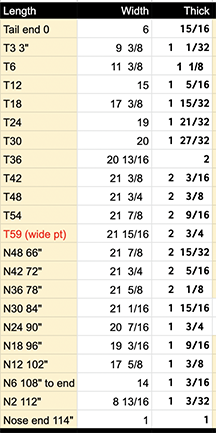Consider a plywood paipo, or a Greenough spoon kneeboard, or for that matter a water ski. Those work just fine, but their volume and floatation is enough to float said craft and little or no more than that.
Huh, right? Maybe we need to look at something other than volume.
A very tiny, very limited version of Naval Architeecture 101
Buoyancy, the static lift of the weight of water volume displaced by the loaded hull** at rest.** I will come back to hulls and displacement, bear with me.
Drag - the resistance to forward motion, measured as a force. Will pretty much always include skin friction and form drag.
Hydrodynamic Lift - the dynamic upward force generated by hull contour and/or angle of attack while said hull is moving through or across the fluid
Displacement hull- a hull travelling through the water at a speed that is too slow to be climbing its own bow wave. This occurs ( with some exceptions, notably racing sailboats) when the speed in statute miles per hour is less than or equal to 4/3 x (square root of the waterline length in feet)
For a 9 foot surfboard with pretty much no rocker, that comes to four statute miles per hour. A walk. I will get back to that too.
Planing hull - a hull operating on top of the water, held up by the dynamic lift . Rule of thumb once again, minimum planing speed in statute miles per hour is 2 x (square root of the waterline length in feet). For that rockerless 9 foot board I mentioned, that’s six miles per hour. A quick walk but by no means a fast run or even a good jog.
Go below a certain speed, the tail sinks and the nose rises, you are in that transitional range between planing and displacement: the board stalls.
So, all surfcraft in use as surfcraft are planing hulls. Period. If you are paddling them or sitting still, then and only then are they displacement hulls, functionally identical to a plank or a buoy or a freighter They both generate lift and drag, but they do it differently…
Now, a new concept. Planing area. How much of the available planing surface is in contact with the water. If a planing surface generates lift L per unit area (less if it’s going slower, more if it’s going faster) and at a given load angle of attack and speed it will remain constant. If it goes faster, the planing area in contact goes down. Ever see a vee bottomed power boat when they get on the throttle? It rises up, less of the boat in the water. Same thing happens with a surfcraft. More power, more speed, less area needed to generate the required lift
Indeed, it really doesn’t matter much what length the board is.if the planing area in use is similar in shape. Longboard, shortboard, whatever, the percentage of the total available planing surface may differ but the planing area will be about the same.
Still with me? Good.
Lets say you have a really thick board. It will float better at rest. There may be a tiny contribution to dynamic lift along the rail when it is planing, the contour is a little different. But volume doesn’t matter, if you made a reinforced skin that shape rather than a thick rail, it would be the same lift. It’s about the shape in contact with the water, not the volume.
But Uncle Doc, I hear you ask, what about ‘displacement hull’ boards?
Okay, we have another concept to discuss. So called ‘surf science’. 95% of it was done by Spicoli. Stoned as a rat, he heard the term ‘displacement hull’ somewhere and maybe through a cannabis haze he saw similarities to a round botton boat hull that travelled through the water slowly. He was dead wrong. The term is bogus. It has no basis in reality.
I said 95% of so called surf science was worthless. The other 5% pretty much comes from the late Dr. Terry Hendricks, who actually knew what he was talking about. Damned few listened to him at all and even less could follow what he was saying. A smarter man than me, kinder and more patient. Way more patient.
For more, let me reccommend Dr. Lindsay Lord’s Naval Architecture of Planing Hulls. https://www.wavetribe.com/products/naval-architecture-of-planing-hulls
hope that’s of use to some
doc…







